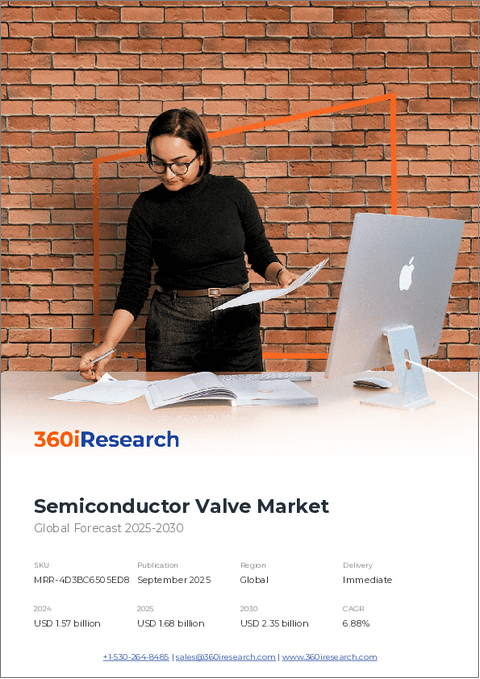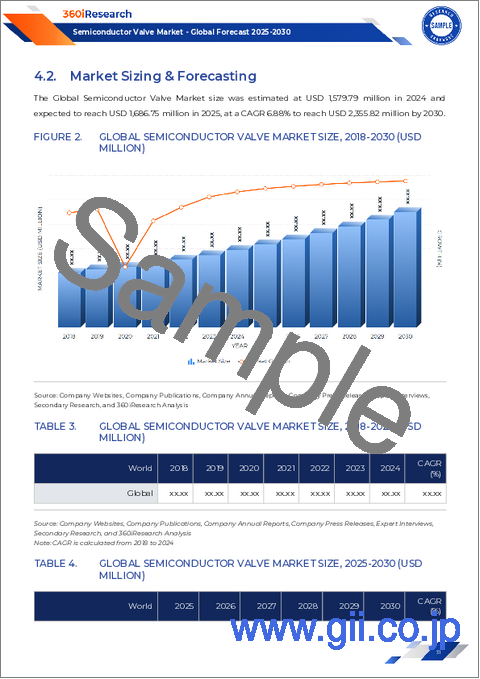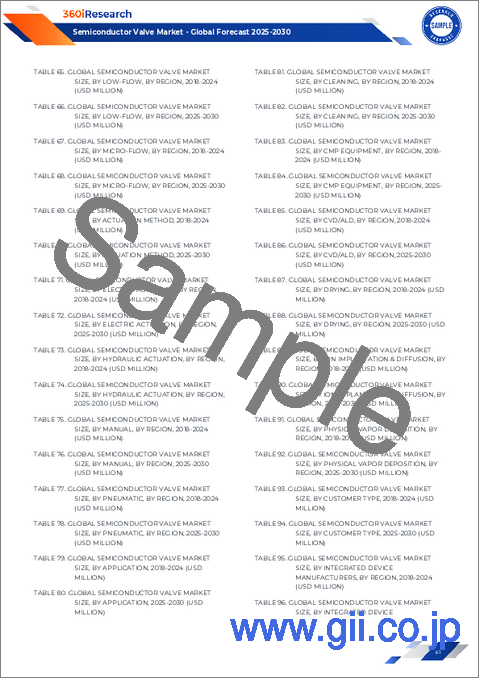|
|
市場調査レポート
商品コード
1809929
半導体バルブ市場:製品タイプ、バルブ材料、流量、用途、流通チャネル別-2025-2030年世界予測Semiconductor Valve Market by Product Type, Valve Material, Flow Rate, Application, Distribution Channel - Global Forecast 2025-2030 |
||||||
カスタマイズ可能
適宜更新あり
|
|||||||
| 半導体バルブ市場:製品タイプ、バルブ材料、流量、用途、流通チャネル別-2025-2030年世界予測 |
|
出版日: 2025年08月28日
発行: 360iResearch
ページ情報: 英文 185 Pages
納期: 即日から翌営業日
|
概要
半導体バルブ市場の2024年の市場規模は15億7,000万米ドルで、2025年には16億8,000万米ドルに成長し、CAGRは6.88%、2030年には23億5,000万米ドルに達すると予測されています。
| 主な市場の統計 | |
|---|---|
| 基準年2024 | 15億7,000万米ドル |
| 推定年2025 | 16億8,000万米ドル |
| 予測年2030 | 23億5,000万米ドル |
| CAGR(%) | 6.88% |
半導体バルブ市場のイントロダクションを公開先端製造と技術進化における重要な役割を強調
半導体バルブ市場は、精密工学と最先端技術の交差点に位置し、マイクロエレクトロニックデバイスの製造において基礎的な役割を担っています。産業がより小さなノードとより複雑なアーキテクチャに向かって進歩するにつれ、流体の流れを調整し、汚染のない環境を維持するバルブはますます不可欠になります。このイントロダクションでは、半導体バルブの範囲、ウエハー処理における重要な責務、メーカーとエンドユーザーが求める進化する性能ベンチマークについて概説します。
高度なプロセス技術とスマート流体技術革新別進化する半導体バルブの情勢を検証する
半導体製造は、プロセスノードがサブ5nm領域に向かって微細化するにつれて変貌を遂げつつあり、バルブ設計とアプリケーションの進化を促しています。従来のウェットエッチングから先進的なドライエッチングや原子層堆積法への移行により、腐食性前駆体や攻撃的な洗浄剤に耐えるバルブへの需要が高まっています。同様に、極端紫外線リソグラフィ(EUV)と高アスペクト比エッチングプロセスの出現により、ウエハー表面全体で均一な膜特性を確保するための超精密流量制御と迅速な作動を備えたバルブへの要求が高まっています。
米国の関税調整が半導体バルブのサプライチェーンと調達戦略に与える戦略的影響の分析
米国が2025年に新たな関税措置を導入したことで、半導体バルブのサプライチェーン全体に波及効果が生じ、調達戦略やコスト構造が変化しています。様々な輸入バルブや関連部品に課される関税により、国内メーカーは調達先を見直す必要に迫られ、クロスボーダー関税を軽減するために現地生産への投資を加速することを選択する施設もあります。これと並行して、国際的なサプライヤーは関税が免除される地域を模索し、自由貿易協定を活用して市場アクセスと競争力のある価格設定を維持しています。
半導体バルブ市場のセグメンテーションから、製品タイプの材料革新とアプリケーション主導のダイナミクスを明らかにする
製品タイプ別にセグメンテーションすることで、需要が最も集中している場所や技術革新が加速している場所に関する重要な視点が得られます。アングルバルブはエッチモジュールや蒸着モジュールに正確な方向制御を提供し、ボールバルブは高圧ガス供給用の強固な密閉性を確保します。ベローズバルブは、漏れのないベローズアッセンブリーによって汚染を防ぐため、超高純度アプリケーションで際立ち、バタフライバルブはスクラバーやガス分配システムでバルクフローを処理します。逆流防止に重要な逆止弁はシステムの完全性を維持し、ダイヤフラムバルブは洗浄ステーションでのスムーズな流れの移行を促進します。ゲートバルブは真空チャンバーの信頼性の高い隔離を提供し、メンテナンスアクセスとプロセスの安定性を確保します。
製造拠点が影響する地域半導体バルブ市場力学の解明規制上の要求と生産能力の伸び
半導体バルブメーカーがどのように戦略を立て、投資に優先順位をつけるかは、地域によって異なります。南北アメリカでは、最先端工場が集中しているため、次世代ロジックやメモリ生産用に設計されたバルブの重要性が強調されています。この地域のメーカーは、リードタイムを短縮し、貿易の不確実性に対するサプライチェーンの回復力を強化するため、現地生産に重点を置いています。
製造イノベーションを進める主要半導体バルブメーカーに注目材料開発とデジタル流体統合
半導体バルブ市場の主なプレーヤーは、差別化された製品ポートフォリオを育成するための研究開発に戦略的に重点を置いています。技術リーダーは、複雑なバルブ内部を製造するための積層造形技術に多額の投資を行っており、その結果、オーダーメイドの流量特性とデッドボリュームの低減を実現しています。バルブのスペシャリストと装置OEMの協業により、先進的なプロセスプラットフォームにシームレスに統合する共同設計ソリューションが生み出されています。
アジャイルサプライチェーンのデジタル化と持続可能なイノベーションに焦点を当てた、半導体バルブリーダーのための実行可能な戦略の策定
業界のリーダーは、貿易リスクを軽減するために、地域生産と多様な調達のバランスをとる柔軟なサプライチェーンアーキテクチャを優先する必要があります。モジュラーバルブプラットフォームに投資することで、企業はスケールメリットを維持しながら、多様なアプリケーションに対応するカスタマイズを加速することができます。ファブインテグレーターとの協力的なパートナーシップは、共同イノベーションをさらに可能にし、バルブ設計が高度なプロセス要件と歩調を合わせて進化することを保証します。
確実な市場洞察のための1次調査特許分析とサプライチェーンマッピングを統合した包括的調査枠組みの概略
調査手法は、業界専門家への1次インタビュー、2次文献調査、サプライチェーンマッピングを組み合わせた多面的なアプローチを採用しました。一次的な洞察は、プロセスエンジニア、調達責任者、バルブ設計者との綿密な議論を通じて収集され、性能のボトルネックと技術革新の優先順位に関する定性的な視点が得られました。
技術および政策促進要因に基づき、半導体バルブ市場のリーダーシップの将来を形作る重要な洞察と戦略的重要事項の要約
このエグゼクティブサマリーでは、半導体バルブ市場に関する詳細な視点を提示し、技術進化、貿易政策のシフト、セグメンテーション力学がどのように収束して業界の軌道を形成するかを説明しました。半導体製造工場がより小さな形状や新しいプロセス化学へと進むにつれ、優れた性能、インテリジェントなモニタリング、持続可能な設計を備えたバルブの需要は加速し続けるでしょう。
目次
第1章 序文
第2章 調査手法
第3章 エグゼクティブサマリー
第4章 市場の概要
第5章 市場力学
- 医療機器における精密流体制御用MEMSベースの半導体バルブの採用増加
- 半導体バルブに圧電アクチュエータを統合し、処理装置の超高速スイッチング速度を実現
- 半導体バルブメーカーと自動車OEMが協力し、電気自動車の熱管理用耐高温バルブを開発
- 産業オートメーションにおけるダウンタイムを最小限に抑えるために、半導体バルブシステムにAI駆動型予知保全ソリューションを実装する
- 高電圧電力変換システムの性能向上のため、シリコンカーバイドベースの半導体バルブへの移行
- 再生可能エネルギー用途における水素燃料インフラの拡大を支援する水素対応半導体バルブの開発
- 航空宇宙用途の半導体バルブモジュールのフットプリントとコストを削減するウェーハレベルパッケージング技術の進歩
第6章 市場洞察
- ポーターのファイブフォース分析
- PESTEL分析
第7章 米国の関税の累積的な影響2025
第8章 半導体バルブ市場:製品タイプ別
- アングルバルブ
- ボールバルブ
- ベローズバルブ
- バタフライバルブ
- チェックバルブ
- ダイヤフラムバルブ
- ゲートバルブ
第9章 半導体バルブ市場バルブ材質
- 真鍮
- ブロンズ
- プラスチック
- PTFE
- PVC
- ステンレス鋼
第10章 半導体バルブ市場流量別
- 高流量
- 低流量
- マイクロフロー
第11章 半導体バルブ市場:用途別
- クリーニング
- CMP装置
- CVD/ALD
- 乾燥
- イオン注入と拡散
- 物理蒸着
第12章 半導体バルブ市場:流通チャネル別
- オフライン
- オンライン
第13章 南北アメリカの半導体バルブ市場
- 米国
- カナダ
- メキシコ
- ブラジル
- アルゼンチン
第14章 欧州・中東・アフリカの半導体バルブ市場
- 英国
- ドイツ
- フランス
- ロシア
- イタリア
- スペイン
- アラブ首長国連邦
- サウジアラビア
- 南アフリカ
- デンマーク
- オランダ
- カタール
- フィンランド
- スウェーデン
- ナイジェリア
- エジプト
- トルコ
- イスラエル
- ノルウェー
- ポーランド
- スイス
第15章 アジア太平洋地域の半導体バルブ市場
- 中国
- インド
- 日本
- オーストラリア
- 韓国
- インドネシア
- タイ
- フィリピン
- マレーシア
- シンガポール
- ベトナム
- 台湾
第16章 競合情勢
- 市場シェア分析, 2024
- FPNVポジショニングマトリックス, 2024
- 競合分析
- Asahi-Yukiza Corporation
- CKD Corporation
- Crane ChemPharma & Energy
- Edwards Vacuum
- Emerson Electric Co.
- Entegris, Inc.
- FITOK Group
- Fujikin Incorporated
- Gemu Gebr. Mueller Apparatebau GmbH & Co. KG
- GPTECH
- Horiba, Ltd.
- Hy-Lok USA, Inc.
- Ichor Systems
- IHARA SCIENCE CORPORATION
- Kim Diaphragm Valves PTY Ltd.
- Metso Corporation
- MKS Instruments, Inc
- Parker Hannifin Corporation
- PRESYS Co., LTD.
- Samson AG
- SMC Corporation
- Swagelok Company
- The Kurt J. Lesker Company
- VAT Group AG






